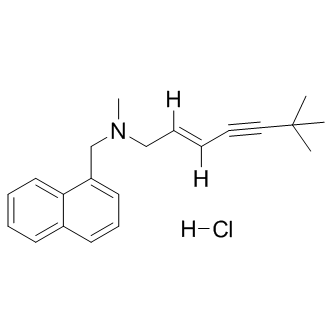
Terbinafine hydrochloride
CAS No. 78628-80-5
Terbinafine hydrochloride( —— )
Catalog No. M15963 CAS No. 78628-80-5
A synthetic antifungal agent that inhibits the synthesis of ergosterol by inhibiting squalene epoxidase.
Purity : >98% (HPLC)
 COA
COA
 Datasheet
Datasheet
 HNMR
HNMR
 HPLC
HPLC
 MSDS
MSDS
 Handing Instructions
Handing Instructions
| Size | Price / USD | Stock | Quantity |
| 25MG | 27 | In Stock |


|
| 50MG | 35 | In Stock |


|
| 100MG | 48 | In Stock |


|
| 200MG | 81 | In Stock |


|
| 500MG | Get Quote | In Stock |


|
| 1G | Get Quote | In Stock |


|
Biological Information
-
Product NameTerbinafine hydrochloride
-
NoteResearch use only, not for human use.
-
Brief DescriptionA synthetic antifungal agent that inhibits the synthesis of ergosterol by inhibiting squalene epoxidase.
-
DescriptionA synthetic antifungal agent that inhibits the synthesis of ergosterol by inhibiting squalene epoxidase; used to treat ringworm, pityriasis versicolor, and fungal nail infections.Fungal Infection Approved(In Vitro):Terbinafine has a primary fungicidal action in vitro against most fungal pathogens, including dermatophytes, and dimorphic and filamentous fungi. Terbinafine specifically inhibits fungal ergosterol biosynthesis at the point of squalene epoxidation. The treated fungal cells rapidly accumulate tlic intermediate squalene and become deficient in the end-product of the pathway, ergosterol.(In Vivo):Terbinafine is not only active after topical application but is very effective in experimental dermatophytoses following oral administration. In fungi infected guinea-pigs, the skin temperature dropps dramatically after the fourth treatment of terbinafine.
-
In VitroTerbinafine has a primary fungicidal action in vitro against most fungal pathogens, including dermatophytes, and dimorphic and filamentous fungi. Terbinafine specifically inhibits fungal ergosterol biosynthesis at the point of squalene epoxidation. The treated fungal cells rapidly accumulate tlic intermediate squalene and become deficient in the end-product of the pathway, ergosterol.
-
In VivoTerbinafine is not only active after topical application but is very effective in experimental dermatophytoses following oral administration. In fungi infected guinea-pigs, the skin temperature dropps dramatically after the fourth treatment of terbinafine.
-
Synonyms——
-
PathwayMicrobiology/Virology
-
TargetFungal
-
Recptorsqualeneepoxidase
-
Research AreaInfection
-
IndicationFungal Infection
Chemical Information
-
CAS Number78628-80-5
-
Formula Weight327.8908
-
Molecular FormulaC21H26ClN
-
Purity>98% (HPLC)
-
Solubility10 mM in DMSO
-
SMILESCC(C)(C)C#C/C=C/CN(C)CC1=CC=CC2=CC=CC=C21.Cl
-
Chemical Name1-Naphthalenemethanamine, N-[(2E)-6,6-dimethyl-2-hepten-4-yn-1-yl]-N-methyl-, hydrochloride (1:1)
Shipping & Storage Information
-
Storage(-20℃)
-
ShippingWith Ice Pack
-
Stability≥ 2 years
Reference
molnova catalog



related products
-
Terbinafine hydrochl...
A synthetic antifungal agent that inhibits the synthesis of ergosterol by inhibiting squalene epoxidase.
-
Itraconazole
A triazole antifungal agent for fungal infections via inhibition of lanosterol 14α-demethylase.
-
Pyraclostrobin
Pyraclostrobin is a strobilurin fungicide that inhibits mitochondrial complex III of fungal and mammalian cells.



 Cart
Cart
 sales@molnova.com
sales@molnova.com


